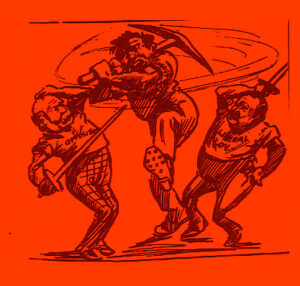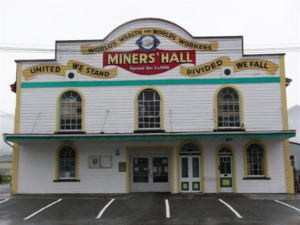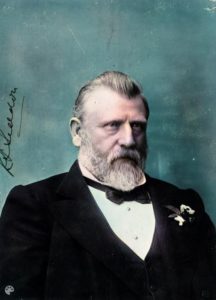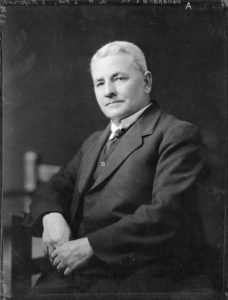1916: Birth of the Labour Party
July 7, 2024
By AHNZ

The Labour Party was formed on 7 July, 1916, in Wellington. It formed its first Ministry (Labour 1.0) in 1935.
Interesting to consider what took them so long. The Labour Party in the UK was founded in 1900. It first formed a government in 1924. In Australia, Labour (ALP) was formed in 1901 and formed a Federal Ministry in 1904. By being early movers these Labour Governments copped it for the Great Depression when it came.
New Zealand’s Labour 1.0, on the other hand, benefited from being late bloomers who were not associated with the crashing economy. In fact, they got hold of power after the recovery was already underway and promptly took credit for it!
Yet, the Socialist cause of ‘the worker’, ‘Labour,’ and ‘solidarity’ had been fermenting in New Zealand just as long as in those other countries. What took them so long? For one thing it’s not exactly in the nature of the New Zealander to gripe and moan about the conditions of his work once he has taken a job on. It is, on the other hand, very much in the nature of certain sets of Australians and British. Finding the market for Socialist agitators in their own lands saturated these sorts of men found their way to New Zealand and proceeded to ‘earn’ a living convincing the Kiwis they were being hard done by.
For example, the Blackball Strike of 1908 (11 weeks) is often mistaken as the formative event and Blackball the birthplace of the Labour Party. The agitators came via other countries and were chiefly Australians Bob Semple and Paddy Webb with Pat Hickey (who then left for Australia.) Tom Mann and Ben Tillett came out from Britain preaching The Strike and Harry Fitzgerald came all the way from Canada. Bill Parry of Waihi Strike fame was another Australian as was Harry Holland. Angus McLagan and Peter Fraser were Brits.
Other foreign agitators included Edward Hartley (English) who was hired by the NZ Socialist Party to head it up for them. He was intended to counter Walter Mills (American) whose own version of Socialism was different to the kind the NZSP desired.
Leftism is hardly an indigenous product although New Zealanders have been coaxed into consuming it. Even when Labour came to power in 1935 it was “…dominated by a Scot, an Englishman, and five ex-Australian miners- who included the Prime Minister.” Ref. Sinclair (1976) Semple was a prolific user of Australian swearing and was “fond of insulting colleagues by calling or comparing them to Australian animals such as kookaburras, kangaroos and dingoes.” Ref. Stuff (2016)
“…other leading ‘Red Feds’ and Socialists, Webb, Savage, W. E. Parry, R. S. Ross, Holland, Mark Fagan, Mick Laracy, and Scott Bennett were also Australians. Fraser was a Scot, and Barker, John Dowgray, E. J. B. Allen, John Glover, E. R. Hartley, and Cooke were Englishmen. Mark Silverstone was Polish. Glover was the only notable militant who had immigrated to New Zealand before the turn of the century and he had arrived in 1899. The only prominent militant leaders born in New Zealand were Hickey and Tim Armstrong..” – Labour’s Path to Political Independence, Barry Gustafson (1980)
“Visiting Stockton in 1912, celebrated socialist orator Edward Robertshaw Hartley drew howls of approval when he called the mine owners those parasites who rub their fat hands together and only separate them to squeeze the worker’s neck”- information panel at Denniston, AHNZ Archive (2021)
“The reputations of Fed leaders Semple and Paddy Webb soared because of their ideological utterances. Great for their future careers in politics but it came at the exploitation of the Strikers who would have to deal with the real world consequences of loosing this fight.” – 1912: Spring Cleaning at Waihi, AHNZ
“Preistly Class….serve as the shamans and witch-doctors of an enemy Tribe, and the purpose of those shamans is to relentlessly disgrace outsiders to the Tribe, which is pleasing to those within the Tribe, while also keeping the shamans in power (because they have no other skills which would earn them money or sex, except the denigration of those considered Unclean).” – Cathedral Decay, Nick Land, Xenosystems Fragments (2021)
“Hickey…was carried shoulder high to police coach which was to take him to Greymouth jail. The police coach was followed by another, with the band on board, as it moved off through the crowds of cheering people. However Hickey’s stay was brief, for his fine was paid by a ‘sympathiser,’ much to his annoyance.” – Carson (1990)
 So, the Labour Movement for many years consisted of various competing cottage industries from offshore. The agents attached themselves to our existing workplaces but the idea they contributed any labour themselves is dubious. Instead, the value a Semple, Parry, Holland, Fraser, or Savage offered was shamanistic. They would publish and preach to the Worker Tribe about its identity with flattery and, in particular, a negative definition of the Bosses. The Worker was offered a suite of resentments and convinced they were hard done by. This conjured pain could be relieved by joining and paying into one of a suite of cults administered by these immigrant shamans. As subscriptions rolled in the fiefdoms emerged and built their castles such as Semple’s Miner’s Hall at Rununga (1908.)
So, the Labour Movement for many years consisted of various competing cottage industries from offshore. The agents attached themselves to our existing workplaces but the idea they contributed any labour themselves is dubious. Instead, the value a Semple, Parry, Holland, Fraser, or Savage offered was shamanistic. They would publish and preach to the Worker Tribe about its identity with flattery and, in particular, a negative definition of the Bosses. The Worker was offered a suite of resentments and convinced they were hard done by. This conjured pain could be relieved by joining and paying into one of a suite of cults administered by these immigrant shamans. As subscriptions rolled in the fiefdoms emerged and built their castles such as Semple’s Miner’s Hall at Rununga (1908.)
Simply because there were so many competing labour cults with differentiated litanies kept them from federating for many years. Jealous of each other, they fought it out over doctrinal lines about whose brand of resentment was correct. The major dividing line was between the militants (eg Red Feds) who wanted to overthrow and the moderates who wanted to reform society from within.
In the scrabble to dominate in this Dominion Victimhood Culture Olympics the country was Unraveling (Third Turning.) The various shamans eventually learned to get along (at least publicly) and then became so powerful that they themselves became the establishment. The very thing they had defined themselves as being opposed to! For example, Peter Fraser who was jailed for refusing to be conscripted in one war then became the Prime Minister presiding over conscription in the next. As Nick Land put it, the main economic value these humbug manufacturers provided their tribe was to relentlessly disgrace and denigrate outsiders. They had no other skills to earn them money or sex except to leverage the power of resentment. As John Lee shows in his writing Labour Priests took their decadent tastes for sex and power with them to parliament. Ref. Lee (1981)
However, there was another big reason why the Labour Movement were unable to form up in New Zealand until 1916.
The Lib-Labs
 That big reason was Richard Seddon, and John Balance before him, ensuring that the “working man” was safely attached to the Liberal Party. Together they were unbeatable. It wasn’t until the Liberals with working class credentials started dying off that the crack opened for Labour to break away. For example, Seddon and Arthur Guinness were both West Coast Members for whom their electorate seats Labour was next in line for.
That big reason was Richard Seddon, and John Balance before him, ensuring that the “working man” was safely attached to the Liberal Party. Together they were unbeatable. It wasn’t until the Liberals with working class credentials started dying off that the crack opened for Labour to break away. For example, Seddon and Arthur Guinness were both West Coast Members for whom their electorate seats Labour was next in line for.
In July, 1899, the Seddons created the first national political party: The Liberal and Labour Federation. AKA The Lib-Labs. All other political groups fell in with this new organisational structure.
 By such means Seddon kept Labour from breaking away. Contained in the Liberal Party.
By such means Seddon kept Labour from breaking away. Contained in the Liberal Party.
The Master must have been laughing himself silly like Jabba the Hutt on his throne for this clever stroke. Or, like Sauron as Lord of the Ring in command of all the little rings.
The various Aussie labour grifters could proselytise among themselves and their working class brethren and take their cut. But they would remain, for 17 years, vassals to King Dick and his heirs.
This, by the way, probably suited the Labour men who would have a hard time knowing what to do with themselves if they were ever legitimised. They knew how to be deviants and oppositional and how to leverage that into support and paydays. It would take a major re-organisation to go from being a pirate to a statesman. What’s amazing is that so many managed it. But, then, they are the ones who tell the story of the Labour Party. We don’t hear about the many contenders who didn’t make it to Parliament House.
“A captured pirate was brought before Alexander the Great. “How dare you molest the sea?” asked Alexander. “How dare you molest the whole world?” the pirate replied, and continued: “Because I do it with a little ship only, I am called a thief; you, doing it with a great navy, are called an emperor.” – Pirates and Emperors, Noam Chomsky (1986)
“A single death is a tragedy, a million deaths are a statistic” – Joe Stalin
 Fighting Bob Semple, for example, traded in his ‘estate’ on the West Coast (Rununga) for politics in the capital at Wellington for 30-odd years and a Ministerial portfolio in Labour 1.0. He had found it within himself to scale up from militant pirate-shaman to Minister-priest.
Fighting Bob Semple, for example, traded in his ‘estate’ on the West Coast (Rununga) for politics in the capital at Wellington for 30-odd years and a Ministerial portfolio in Labour 1.0. He had found it within himself to scale up from militant pirate-shaman to Minister-priest.
Labour’s first 2 leaders, Alfred Hindmarsh (Australian) and Harry Holland (Australian) were spared from having to metaporphise into a higher form of political parasite because they died. The performed the essential role of booster rockets for the other men who would go forth into the political heavens. Ref. 1933: Death of Harry Holland, AHNZ
Joe Savage was next leader and adjusted to this growth anxiety by perhaps 2 ways. Firstly, he was buffered by not being very intelligent or principled in the first place. He never did pick a side between militant and moderate unionism. His main skill, as Sinclair (1976) puts it, was exuding “sympathy and warmth in cloudy phrases.” Secondly, in my opinion, there is a deadly moral cost to be personally paid for inflicting the initiation of force one one’s fellow man while pretending to have consent. So, Savage as first Labour Prime Minister was following in William Hobson’s footsteps who lasted 2 years before his heart objected and killed him. Savage managed just over 4 years before cancer removed him from office. Ref. 1940: Savage Death, AHNZ
One of the clever things Seddon had done to capture the ‘Current Thing’ of the Labour Movement was to create Labour Day as a public holiday kicking off with 11 October, 1900. That goes to show how long a popular thing had been going but without it being able to harness its own autonomy.
Likewise, Jacinda Ardern’s Labour 6.0 Ministry captured the ‘Current Thing’ of the moment by creating an 12th public holiday in the form of Matariki day from 24 June 2022. New Zealanders at that time found the Black Lives Matter movement to be in vogue so consented. Ref. 2001: Matariki A State Odyssey, AHNZ
What few realise is that Ardern wasn’t just creating a public holiday monument to her own power by creating Matariki but also her party. The ship her family came in on was the Pleiades which is another name for Matariki. Likewise, when the Labour Party had its own newspaper it was called The Southern Cross (1946-1951) which is also another name for Matariki. It’s hard not to think that politicians are up to their usual game of stamping down their own brands by turning even holidays into their own propaganda.
The Labour Party of New Zealand is now about 120 years old and has had 6 ministries. It will be interesting to see what form Labour 7.0 takes the next time they broker a coalition deal. Certainly none of the ministries bare much resemblance the political party formed in 1916.
—
Image ref. The Political Conflict, John Blomfield, Free Lance (1908;) The Unauthorized Version, Ian Grant (1980)
Image ref. The many re-namings of the NZ Labour Party. A Ship of State or The State of A Ship, Tom Glover, Truth (1916)
Ref. p120 and p91, Walter Nash, Keith Sinclair (1976)
Ref. The John A. Lee Diaries 1936-1940, John Lee (1981)
Ref. p38 The Longest Beat, Carson (1990)
 Like Comment Share
Like Comment Share





